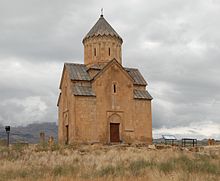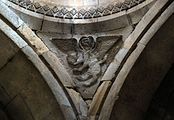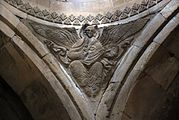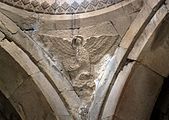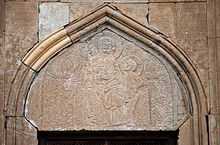Areni Church
Coordinates: 39 ° 43 ′ 22 " N , 45 ° 11 ′ 29" E

The Areni Church ( Armenian Արենիի եկեղեցի ), also Surb Astvatsatsin of Areni (Սուրբ Աստուածածին եկեղեցի) is one of the Virgin Mary ( Surb Astvatsatsin ) dedicated to cross-domed church of the Armenian Apostolic Church in the village of Areni (formerly Arpa) in the south Armenian province of Vayots Dzor Province . The Mother of God Church, which is important in art history because of its exceptionally harmonious shape and ornamental design, was designed by the architect and sculptor Momik and decorated with figurative reliefs. The founding inscription is dated 1321.
location
The 1800-inhabitant village of Areni, located at an altitude of 1054 meters in the valley of the Arpa River , forms the center of one of the most famous Armenian wine-growing regions. The Church of Our Lady stands isolated outside the village on a hill above the south bank of the Arpa. It can be seen from afar, even if the pink tuff stone of the masonry barely stands out in color against the backdrop of the steep mountain ridge immediately behind the church. From the center of the village, one kilometer south of the M2 expressway , a road leads to the church at the bridge over the Arpa. One kilometer east of the M2 branches off a side road to the Norawank monastery , which is just before the end of a picturesque valley on the mountain slope.
The flat area around the church is overgrown with grass, on the slope to the river and on the mountain flank in the south, scree and rock faces without vegetation predominate. Like most of the small cross-domed churches in Armenia, the Areni Church is surrounded by an old cemetery. A few meters away, modern graves are spread across the plain up to the mountain.
history

Simple, roughly shaped tombstones that are placed around the church may have come from the early days of Christianization. The more finely crafted hachkars , on the other hand, are contemporary with the church. Their motivic origins go back to pre-Christian times. Some of the reliefs of these memorial stones show - characteristic of the region - men and wine glasses drinking wine.
The founding inscription from 1321 above the west portal mentions the architect Momik and his client, Bishop Yovhannes Orbelian von Norawank. Momik had become famous for his book illuminations made around 1300 at the University of Gladzor (which was probably located in the Tanahat monastery ) before he came to Noravank, where he worked as a sculptor and created reliefs for churches and khachkars. The design of the Areni Church shows Momik at the height of his creativity. The figure relief above the west portal of the Gawit in Norawank, which was created at the same time or a little earlier, is also attributed to Momik.
The region on the Arpa River belonged to the center of the principality of the Orbelian Dynasty since the end of the 13th century. While the north of today's Armenia suffered under Mongol rule in the 14th century , the regions of Arpa and, further south, Sjunik experienced a cultural heyday with the independent Orbelian princes. Thanks to their patronage, numerous churches were built and monasteries expanded. Ruins have been found near the Areni Church that may have belonged to Prince Tarsayich Orbelian's palace in the 13th century. He also had a bridge built over the Arpa near the church between 1265 and 1287.
The church was badly damaged in an earthquake in 1840. In photos from the first half of the 20th century, the drum that collapsed during the earthquake and the dome are still missing . The building was restored from 1967 to 1972. In 1998 the dome was rebuilt during the tenure of Catholicos Karekin Sarkissian .
Design
At the beginning of the 7th century, small cross-domed churches were built. According to the number of apses, they were designed as monoconchos (a semicircular altar apse in the east like Lmbatavank ), trikonchos (three apses, Church of Our Lady in Talin ) or as a completely symmetrical basic shape with four conches ( tetraconchos ). Most of them belonged to a cemetery and can be assigned functionally to the memorial buildings. In addition to the central buildings, whose cross-shaped floor plan is evident in the outline, encased cross-domed churches were developed. Your floor plan is inscribed in an outer rectangle. The monoconchos of the Areni Church correspond to this type, whereby the belt arches of the drum rest only on the two eastern inner corners and - as a specialty in Armenia - are supported in the east by two free-standing pillars. The two-pillar construction is common in medieval Byzantine and Georgian church architecture, while in small Armenian cross-domed churches the tambour rises above the four inner corners of the cruciform base plan, and in larger churches the tambour and dome rest on four free-standing pillars. Models for the latter domed basilicas were the cathedral of Odsun (possibly the middle of the 6th century) and the second cathedral of Surb Grigor of Dwin from the beginning of the 7th century.
The two eastern arches are formed by the partition walls of the horseshoe-shaped apse . Rectangular side rooms with small round apses fill the outer corners on the side of the apse. The altar apse, raised by a bema (podium), receives light from a double window, which consists of two cross-shaped openings. The side rooms are lit by narrow window slits. Another window opening of the same size is in the gable on the north side. The two entrances are in the middle of the west and south walls.
In the corners of the central square formed by the guide wall arches Pendentifs indoor circular basic shape on the main cylinder. Each pendentif is designed with a three-dimensional, protruding figural relief of one of the four evangelist symbols (tetramorphs), which are bounded by a circumferential geometric frieze to the drum. The lively style of the figures is unusual for Armenia and was characterized as Gothic with reference to Momik's origins in Cilicia , because there he could have got to know design elements of European church architecture through contact with crusaders . In any case, the tetramorphs were widespread in Byzantine painting and made their way from there in a simplified form to the sculptural design of some Armenian churches from the 10th to 13th centuries.
Tetramorph in the southeast: Markus as a lion
Tetramorph in the northeast: Matthew as a person or angel
Tetramorph in the northwest: Johannes as an eagle
Tetramorph in the southwest: Luke as a bull
A triple staggered horizontal frieze runs in the upper wall area on all sides. It forms the transition between the apse wall and the dome half-shell, replaces the capitals between the half-columns at the wall corners and belt arches, and overcomes the upper edge of the arched windows with a rectangular offset. Apart from the figurative representations, the ornamental design is composed sparingly and conclusively in every detail.
The reconstructed, outside 24-sided tambour is divided by eight window slots with two V-shaped recessed niches in between. At the upper ends of the wall surfaces, rectangular and round bulge profiles alternate, so that the use of these economical means results in an unusually lively design. The dome is crowned by a canopy , which reaches the transition to the wall with a triple stepped and jagged eaves. The frames of the windows and doors on the west and south sides are connected by round profile bars.
The two tympanum fields above the entrances are framed by pointed arch profiles. Above the south portal, the field is casually decorated with the motif of a vegetable-shaped cross. The tympanum above the main entrance in the west is of particular importance. The bas-relief shows a seated Maria with child , designed by Momik, against a background with dense plant tendrils in the special design as Hodegetria . The shape is possibly influenced by the somewhat older tympanum on the Gawit in Norawank. According to another opinion, the tympanum in Norawank is stylistically different from Areni and dates back to the end of the 13th century. A medallion on the lower right edge of the west pediment contains a head with Mongolian facial features. Perhaps the Mongolian head stands for the rule of this people over the Armenians.
literature
- Patrick Donabédian: Documentation of the art places. In: Jean-Michel Thierry: Armenian Art. Herder, Freiburg / B. 1988, p. 510, ISBN 3-451-21141-6
- Paolo Cuneo: Architettura Armena dal quarto al diciannovesimo secolo. Volume 1. De Luca Editore, Rome 1988, p. 394
Web links
- Rick Ney: Vayot's Dzor. (PDF; 1.7 MB) TourArmenia, 2009, p. 3f
- Areni Church. Armeniapedia
- Church of Holy Virgin in Areni . armenica.org
Individual evidence
- ↑ official statistics from January 2008: RA Vayots Dzor Marz. (PDF; 165 kB) armstat.am
- ↑ Stepan Mnazakanjan. Architecture. In: Burchard Brentjes , Stepan Mnazakanjan, Nona Stepanjan: Art of the Middle Ages in Armenia. Union Verlag (VOB), Berlin 1981, p. 64; Jean-Michel Thierry, p. 53
- ↑ Stepan Mnazakanjan. Architecture. In: Burchard Brentjes, Stepan Mnazakanjan, Nona Stepanjan: Art of the Middle Ages in Armenia. Union Verlag (VOB), Berlin 1981, p. 70
- ↑ Stepan Mnazakanjan. Architecture. In: Burchard Brentjes, Stepan Mnazakanjan, Nona Stepanjan: Art of the Middle Ages in Armenia. Union Verlag (VOB), Berlin 1981, p. 91
- ^ Patrick Donabédian: Documentation of the art places. In: Jean-Michel Thierry, p. 510
- ^ Patrick Donabédian: Documentation of the art places. In: Jean-Michel Thierry, p. 498
